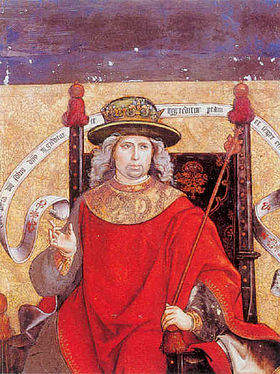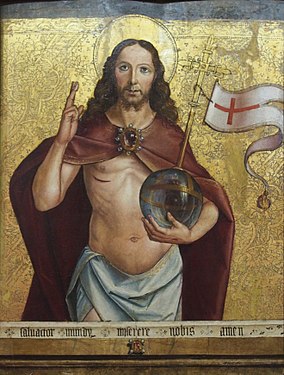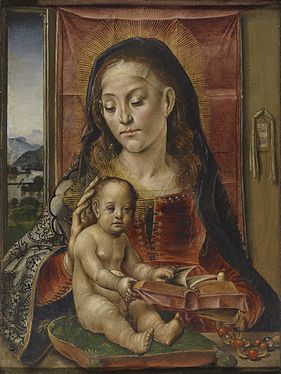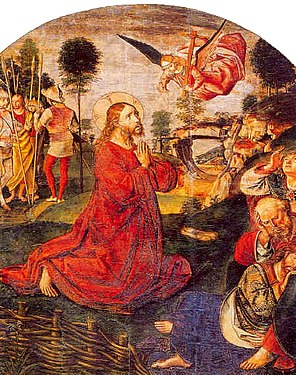Pedro Berruguete
Pedro Berruguete (Paredes de Nava, Palencia c. 1450 -Madrid? 1503) was a Spanish painter, located in the transition from the Gothic style to Renaissance painting.
After his training, probably with Fernando Gallego in Salamanca, he would have traveled to Italy at a very young age, where "Pietro Spagnuolo" is documented working under the patronage of the Duke of Urbino, Federico de Montefeltro. That Italian stay would have allowed him to meet the main artists of the Quattrocento, such as Melozzo da Forlì, and learn Renaissance techniques and manners, such as mastery of space, anatomy or the variety and naturalness of gestures, as well as architectural elements and decorative patterns typical of the Renaissance, although back in Castile, around 1483, these characteristics are not so evident in his painting.
He was the father of one of the most prominent artists of the Hispanic Renaissance, Alonso Berruguete.
Biography
Pedro Berruguete was born in Castile and his early works reveal this origin and his adherence to the gothic styles that predominated in the art of the time. The artistic learning of him is quite unknown. He also raises many unknowns with his trip to Italy to work at the Ducal Palace in Urbino, where he would have coincided with the Flemish Joos van Wassenhove (Justo de Gante). The mention of a "Pietro Spagnuolo pittore" working in Urbino in 1477, led to the so-called being identified with Pedro Berruguete since 1927, assuming an Italian training and stay for the painter that is not accepted by all critics. During his trip to Italy, a series of portraits are attributed to him there, such as that of Pope Sixtus IV (Louvre Museum), and the Portrait of Federico de Montefeltro and his son Guidobaldo (Urbino, Ducal Palace), in addition to collaborate on works by other authors, such as Piero della Francesca.
However, the oldest evidence of the presence of a Spanish painter at the court of Urbino, in addition to the aforementioned document from 1477, is found in the work of Pablo de Céspedes, who in his Discurso de la comparación of ancient and modern painting and sculpture, written in Córdoba in 1604, establishes a clear difference between "Berruguete el viejo, father of Berruguete" and the "other Spaniard who in the palace of Urbino, in a dressing room of the duke, painted some heads as portraits of famous men, wonderfully good". After his alleged stay in Italy, Berruguete would have returned to Castile, where he found a good clientele in the ecclesiastical estate, focusing his production on paintings for altarpieces.
The truth is that in 1478, only one year after being mentioned in Urbino as "Pietro Spagnuolo" and four before the probable date of the portrait of Federico de Montefeltro, Pedro Berruguete married in Paredes de Nava, dating from that same year its tables of Santa María del Campo.
According to Ceán Bermúdez, Berruguete appears documented in Toledo in 1483, where it decorates the walls of the Old Tabernacle Chapel of the Primate Cathedral, although the surviving documentation refers rather to the year 1493. After what would have been a first stay in Toledo he would have returned to his native town and executed the altarpiece of Santa Ana and the Virgin (1485-1488). On this date he would have returned to Toledo and, after a period of documentary silence, he is found there again in 1494. Commissioned by the inquisitor Tomás de Torquemada, he made the main altarpiece of the Monastery of Santo Tomás de Ávila. Dismembered, the painting of the Auto de Fe presided over by Santo Domingo de Guzmán stands out, preserved with other panels of said altarpiece in the Prado Museum.
There is the possibility that the painter worked in the service of Isabel the Catholic. One of the royal commissions would be Saint John the Evangelist on Patmos, which Berruguete delivered on May 3, 1499 in the old Alcázar of Madrid and that today is preserved in the Royal Chapel of Granada.
Around 1500 he worked for the now-defunct Hospital de la Latina in Madrid, at the request of Beatriz Galindo, founder of this institution and tutor to Queen Elizabeth. One of his most accomplished works, The Virgin with Child in a throne, presided over the chapel of the aforementioned hospital until its demolition in 1906, to later be transferred to the Museum of History of Madrid and the Museum of San Isidro (where it returned after temporary storage at the Prado Museum).
His last stage was spent in his hometown, Paredes de Nava, where he painted works such as the partially disappeared Guaza de Campos altarpiece from 1501. In his painting, the influence of the Italian Renaissance stands out, in the fact of wanting to frame the figures and actions in space, through the use of light and perspective, although sometimes not well resolved. Back in Castilla, he would have lost interest in detail and his figures become more sober, perhaps as an adaptation of his style to the more archaic tastes of his clients.
Work
First stage
First stage (between 1470 and 1471): Verification of the cross of Christ of the church of San Juan de Paredes de Nava or the Adoration of the Magi of the Varez Fisa collection.
Second stage
Second stage and supposed journey of learning in Italy (1471-1483). There are not too many testimonies of Berruguete's work preserved at this time, and those that do exist are controversial in terms of authorship. Particularly noteworthy is the Portrait of Federico de Montefeltro and his son Guidobaldo (Gallery of the Marches, Ducal Palace of Urbino), an excellent and original sample of portraits & # 34; of apparatus & # 3. 4; in an interior; and the series of Illustrious Men, distributed among various museums, including the Louvre. This Italian stay would have been interrupted by a return trip to Paredes de Nava in 1478 to get married, then returning to Italy.
Third stage
Third stage (1483-1503) of creation in Castile. At this time he adapts the style that he learned in Italy to the tastes of the Castilian clientele, more conservative and attached to the manners of the Gothic.
His masterpiece are some paintings representing the Kings of Judah, in the main altarpiece of the church of Santa Eulalia de Paredes de Nava, where despite resorting to archaic elements (frontal composition, golden background), he achieves a gallery of portraits of intense verismo. Outstanding in the series are King David, with his penetrating gaze, King Solomon and King Hezekiah.
Many of his best works from this and other stages can be seen in different locations in the province of Palencia, such as The Adoration of the Kings and The Annunciation, preserved in the Parish Museum of Santa María de Becerril de Campos, The Suitors of the Virgin and The Crucifixion that are kept in the Diocesan Museum of Palencia, or The Lamentation on the body of Christ of the cathedral of Palencia.
In the church of the Assumption of Santa María del Campo, in Burgos, two important works from this period are preserved: Decapitation of the Baptist and Baptism of Christ, which They were part of an altarpiece of the life of the Baptist, dated between 1483 and 1485, being one of the first works of this third Castilian stage. Innovations in composition and perspective brought from Italy are evident in these two works. In the Decapitation, he uses as background an architecture inspired by what Francesco Laurana was doing at that time in Urbino.
The Annunciation of the Cartuja de Miraflores stands out for the detail in the objects and the interesting game of perspectives, which creates a perfect spatial illusion. In all these works the figures appear highly individualized, and the mastery of space, perspective and composition is enriched by an accurate sense of drawing and a wise use of colour.
His last commission was the main altarpiece of the cathedral of Ávila, which he could not complete due to his death. For this work, of spectacular late-Gothic architecture, he painted several tables with stories from the life of Christ for the body of the altarpiece, and figures of patriarchs for the predella. In these paintings, perhaps at the request of the patrons, he conforms to the gothic schemes that prevailed in Castile at that time, using a gold background and somewhat rigid compositions. The figures are of a more robust and monumental canon than in previous works, perhaps in order to make them stand out in the distance from the main chapel. The death of the master caused the altarpiece to be completed by Juan de Borgoña.
In 2003, on the occasion of the commemoration of the fifth centenary of the painter's death, a monographic exhibition was dedicated to him in his hometown, Paredes de Nava, which brought together the best of his painting and shed light on some aspects of his life and work.
Gallery of works
Contenido relacionado
Fra Angelico
Grave (band)
John cleese


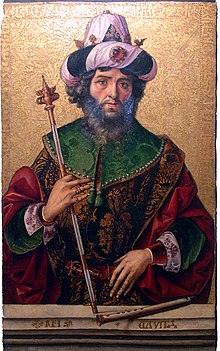


![Auto de Fe presidido por Santo Domingo de Guzmán, c.1495[10] (Museo del Prado, Madrid)](https://upload.wikimedia.org/wikipedia/commons/thumb/4/45/Pedro_Berruguete_Saint_Dominic_Presiding_over_an_Auto-da-fe_1495.jpg/228px-Pedro_Berruguete_Saint_Dominic_Presiding_over_an_Auto-da-fe_1495.jpg)



